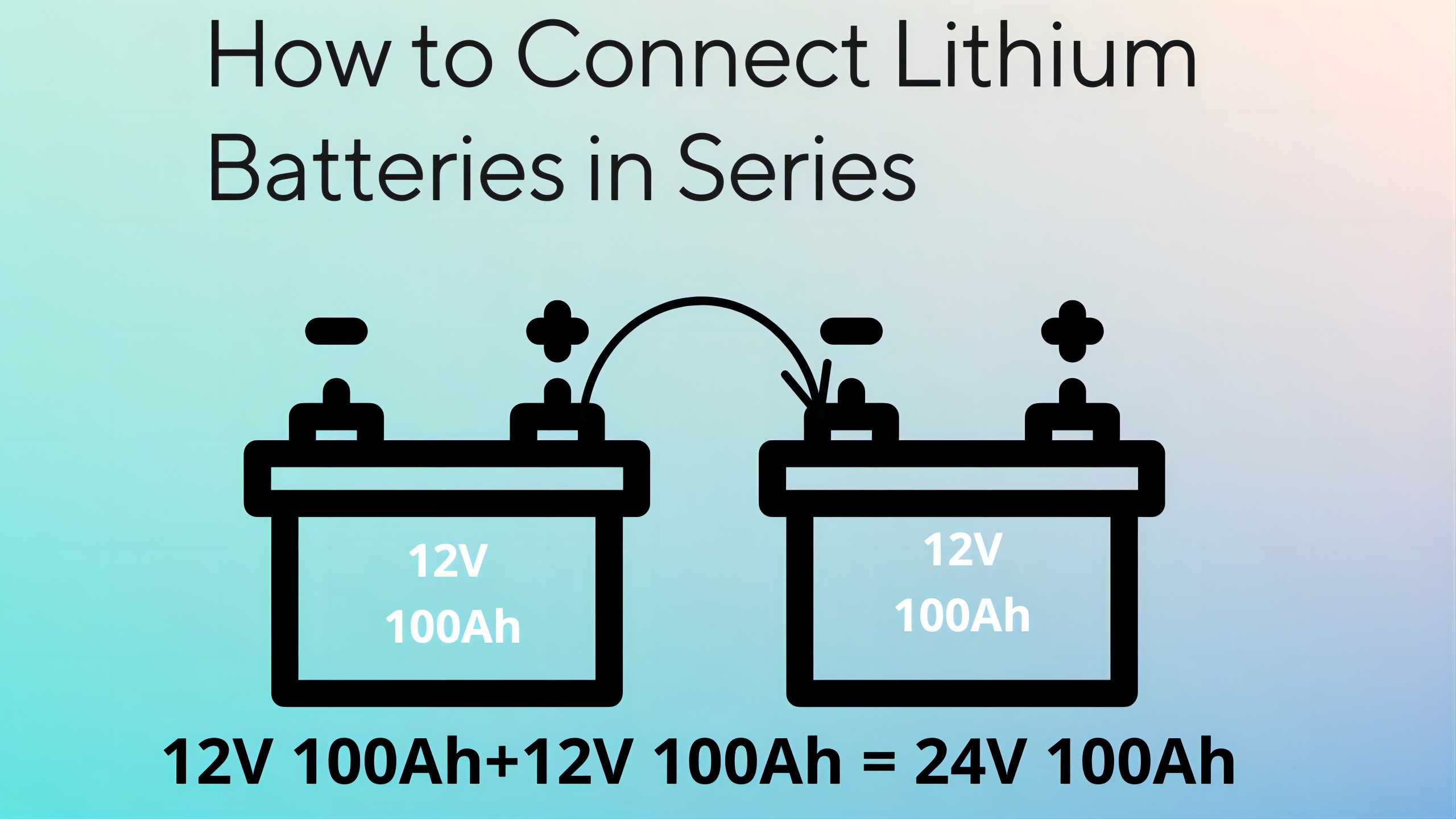In a lithium battery pack, multiple lithium cells are connected through series and parallel connections to achieve the required sufficient working voltage. If you need higher capacity and greater current, you should connect lithium cells in parallel. The aging cabinet of the lithium battery assembly equipment, by combining series and parallel methods, can meet the standards of high voltage and high capacity.
Lithium battery parallel connection: The voltage remains unchanged, the battery capacity is added together, the internal resistance is reduced, and the power supply time is extended.
Lithium battery series connection: The voltage is added together, the capacity remains unchanged.

Step 1: Gather the necessary equipment and materials. You will need lithium-ion batteries, battery connectors or busbars, insulated wire, a battery management system (BMS), and appropriate tools such as wire cutters, strippers, and crimpers.
Step 2: Ensure safety precautions. Work in a well-ventilated area and follow proper safety guidelines for handling lithium-ion batteries, including wearing protective gloves and goggles.
Step 3: Verify battery compatibility. Ensure that the lithium-ion batteries you are using are of the same chemistry, voltage rating, and capacity. Mixing different types of batteries can lead to imbalances and potential safety hazards.
Step 4: Prepare the batteries. Check the battery voltage levels to ensure they are similar. If needed, charge or discharge the batteries to bring them to a similar voltage range. Confirm that all batteries are in good condition without any physical damage or swelling.
Step 5: Plan the series connection. Determine the desired total voltage for your battery pack and calculate the number of batteries required. Each battery will contribute its voltage to the total. For example, if you have four 3.7V batteries, the total voltage will be 14.8V (3.7V x 4). Arrange the batteries in a series configuration accordingly.
Step 6: Connect the batteries. Use battery connectors or busbars to establish electrical connections between the batteries. Connect the positive terminal of one battery to the negative terminal of the next battery. Continue this connection until you have connected all the batteries in series. Ensure that the connections are secure and tight.
Step 7: Insulate the connections. To prevent short circuits and ensure safety, insulate the battery connections using electrical tape or heat-shrink tubing. Insulate both the positive and negative terminals of each battery to avoid any accidental contact.
Step 8: Install the Battery Management System (BMS). The BMS is crucial for monitoring and balancing the batteries in the series configuration. Follow the manufacturer's instructions to connect the BMS to the battery pack, ensuring the correct wiring connections.
Step 9: Verify the connections. Double-check all the connections, ensuring that no wires are loose or touching each other. Confirm that the BMS is properly connected, and the battery pack is secure.
Step 10: Test the battery pack. Before putting the battery pack into practical use, perform a thorough test using appropriate equipment. This includes checking the voltage balance, capacity, and overall performance of the battery pack.
It is important to note that lithium-ion batteries can be potentially hazardous if mishandled. If you are not familiar with battery pack assembly or have limited experience, it is recommended to seek assistance from professionals or experts in the field to ensure safety and reliability.
Step 1: Gather the necessary equipment and materials. You will need lithium-ion batteries, battery connectors or busbars, insulated wire, a battery management system (BMS), and appropriate tools such as wire cutters, strippers, and crimpers.
Step 2: Ensure safety precautions. Work in a well-ventilated area and follow proper safety guidelines for handling lithium-ion batteries, including wearing protective gloves and goggles.
Step 3: Verify battery compatibility. Ensure that the lithium-ion batteries you are using are of the same chemistry, voltage rating, and capacity. Mixing different types of batteries can lead to imbalances and potential safety hazards.
Step 4: Prepare the batteries. Check the battery voltage levels to ensure they are similar. If needed, charge or discharge the batteries to bring them to a similar voltage range. Confirm that all batteries are in good condition without any physical damage or swelling.
Step 5: Plan the parallel connection. Determine the desired total capacity for your battery pack and calculate the number of batteries required. Each battery will contribute its capacity to the total. For example, if you have four 2000mAh batteries, the total capacity will be 8000mAh (2000mAh x 4). Arrange the batteries in a parallel configuration accordingly.
Step 6: Connect the batteries. Use battery connectors or busbars to establish electrical connections between the batteries. Connect the positive terminal of one battery to the positive terminal of the next battery. Similarly, connect the negative terminal of one battery to the negative terminal of the next battery. Continue this connection until you have connected all the batteries in parallel. Ensure that the connections are secure and tight.
Step 7: Insulate the connections. To prevent short circuits and ensure safety, insulate the battery connections using electrical tape or heat-shrink tubing. Insulate both the positive and negative terminals of each battery to avoid any accidental contact.
Step 8: Install the Battery Management System (BMS). The BMS is crucial for monitoring and balancing the batteries in the parallel configuration. Follow the manufacturer's instructions to connect the BMS to the battery pack, ensuring the correct wiring connections.
Step 9: Verify the connections. Double-check all the connections, ensuring that no wires are loose or touching each other. Confirm that the BMS is properly connected, and the battery pack is secure.
Step 10: Test the battery pack. Before putting the battery pack into practical use, perform a thorough test using appropriate equipment. This includes checking the voltage balance, capacity, and overall performance of the battery pack.
It is important to note that lithium-ion batteries can be potentially hazardous if mishandled. If you are not familiar with battery pack assembly or have limited experience, it is recommended to seek assistance from professionals or experts in the field to ensure safety and reliability.

Parallel connection is used to obtain more power, multiple batteries can be connected in parallel. In addition to paralleling batteries, another option is to use a larger battery. Because the available batteries are limited, this method is not suitable for all applications. Moreover, large-sized batteries are not suitable for the required shape factor of the dedicated battery. Most chemical batteries can be used in parallel, and lithium batteries are most suitable for parallel use. For example, the parallel connection of five batteries maintains the battery voltage at 3.6V, and the current and operating time are increased by five times. The impact of high impedance or "open" batteries on the parallel battery circuit is less than that of series connection, but the parallel battery pack can reduce the load capacity and shorten the operating time.
When using series and parallel connection methods, the design is flexible and can meet the rated voltage and current required for standard battery sizes. It should be noted that due to the different connection methods of lithium batteries produced by the lithium battery spot welding machine, the total power will not change. Power equals voltage multiplied by current, and for lithium batteries, series and parallel connection methods are very common. The most commonly used battery pack is the 18650 lithium battery, which has a protective circuit and a lithium battery protection board. The lithium battery protection board can monitor each battery in series, so its maximum actual voltage is 4.2V. This lithium battery protection circuit (i.e., the lithium battery protection board) can also be used to monitor the status of each battery in series connection.
When using 18650 lithium batteries in series, the following basic requirements must be followed: the voltage should be consistent, the internal resistance should not exceed 5 milliohms, and the capacity difference should not exceed 10 milliamperes. Another is to keep the battery connection points clean, each connection point has a certain resistance. If the connection point is not clean or the connection point increases, the internal resistance may be very high, which can affect the performance of the entire lithium battery pack.
In general, when using lithium batteries in series and parallel, it is necessary to match the lithium battery cells, and the matching standards are: the voltage difference of lithium battery cells ≤3mV, the internal resistance difference of lithium battery cells ≤5mΩ, and the capacity difference of lithium battery cells ≤10mA.
When connecting batteries in parallel, the same type of batteries must be used. Different batteries have different voltages, and after paralleling, the battery with higher voltage will charge the battery with lower voltage, consuming electrical energy.
When connecting batteries in series, the same type of batteries should also be used. Otherwise, after series connection of batteries with different capacities (for example, the same type of batteries with different degrees of newness), the battery with smaller capacity will discharge first, the internal resistance will increase, and at this time, the battery with larger capacity will discharge through the internal resistance of the small-capacity battery, consuming electrical energy, and will also recharge it. In this way, the voltage on the load will be greatly reduced, and it will not work, and the battery with larger capacity is only equivalent to the battery with smaller capacity




The lab focuses on solid-state battery research to overcome traditional lithium batteries' safety and energy density issues, supporting environmental sustainability. It develops innovative solid-state electrolytes, refines electrode materials, and investigates ion transfer and interface stability to revolutionize battery technology.

The electric vehicle battery industry is rapidly developing, focusing on technological innovation, market competition, and sustainability. Research hotspots include solid-state batteries, new types of electrolytes, BMS optimization, and recycling technologies. The environmental adaptability, safety, and economic viability of batteries are key research areas, and the industry is expected to undergo more innovation and transformation.

We specialize in battery preparation technology research, focusing on overcoming existing energy storage challenges by innovating in electrode materials, battery chemistry, and manufacturing processes to improve performance, enhance safety, and reduce costs. Sustainability and recycling technologies for batteries are also emphasized to mitigate environmental impacts and foster the growth of green energy.